Quick search
CTRL+K
Quick search
CTRL+K

Alice Springs is in Australia’s interior called The Red Center, and with the red color of the soil, you quickly see why. The sunsets add an extra red glow and that is just the icing on the cake. Already from the air you can see the red earth, and in the middle of it all you find the oasis Alice Springs, which despite its relatively small population is like a big city in the desert.
The city of Alice Springs is not one of Australia’s largest, but on the other hand the sights are unique. The history of colonizing and developing the vast land area is something that one can follow around the city, which also serves as a kind of capital for the country’s indigenous population, the Aborigines, whose arts and traditions, you can see several places in the city.
Institutions such as the Royal Flying Doctor Service and the School of the Air portray the story of living in and developing life in central Australia, where there is often a long way to go to a neighbor. The sites have fine museums that provide interesting knowledge into this part of the community. In the city you can also take a shopping trip to Todd Mall or see it all from above from the top of Anzac Hill.
On an exciting drive through the countryside you can enjoy the scenery on the way to eg Ayers Rock and The Olgas, which are unforgettable rock formations. A walk around Ayers Rock or into The Olgas is one of the things that gives lasting impressions from a walk down under, and both the sunrise, sunset and the star’s on a dark sky create special moods.
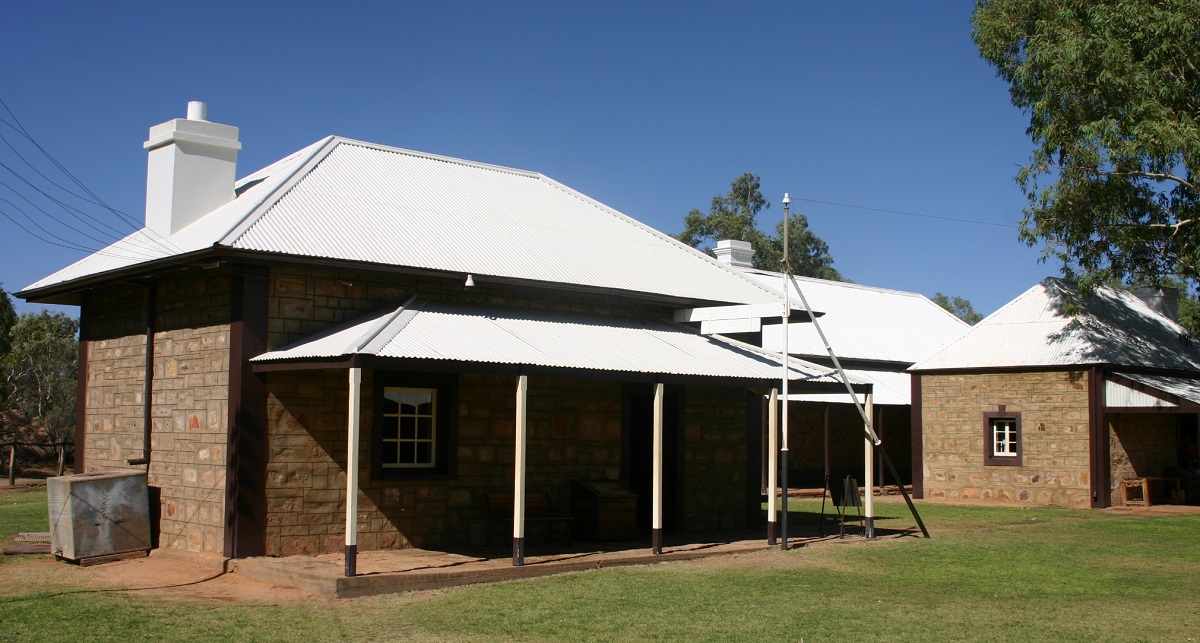
Alice Springs’ historic telegraph station marks the site of the first European settlement in the area. When the Overland Telegraph Line was to be established between Adelaide and Darwin (and from there on to Asia), 12 telegraph stations were built, of which Alice Springs’ is the best preserved of them.
The buildings were erected in 1871-1872, and it functioned as a telegraph station for approximately 60 years. For a period thereafter, a school was set up here. Today, the place functions as a historical museum, and you get a particularly good impression of the living conditions back then.
The area around the telegraph station is also interesting to look at. Behind the buildings lies the bed of the normally completely dry river Todd River, in which the locals rarely see water. You can see the place where John McDouall Stuart and his entourage found the water that decided to build here at all. Beautiful trees and many parrots are also part of the experience on the grounds of the telegraph station.
The Royal Flying Doctor Service is the name of the Australian flying medical corps that began their flights in 1928. In 1939 a base was established in Alice Springs. Over time, several bases were established so that the large country could be covered by doctors with a relatively short response time. The base in Alice Springs is still active, and on a visit here you will, among other things, pass the control center so that you can follow the work.
Every year, several million kilometers are flown, and tens of thousands of citizens in outlying areas without immediate medical assistance are assisted. Both here and in the Central Australian Aviation Museum, also located in Alice Springs, you can get to know the corps.

As the first of its kind, the School of the Air in Alice Springs began distance learning in 1951 from the offices of the Royal Flying Doctor Service. The idea originated in 1944, when Adelaide Miethke proposed using two-way radios to teach children in the Australian outback, which is far from regular schools.
In addition to the school teaching itself, in 1955 a social aspect also entered the School of the Air, when the first meeting week was held. 30 students aged 5-15 met here. In 1974, the school’s teachers began visiting each student once a year. Enrollment increased and when the school opened on its current site in 1978, 13 teachers were employed.
In 1996, the visitor center at the School of the Air opened, and here you can learn about the history of the school and its importance to the students, who continuously use new technologies in connection with distance learning.
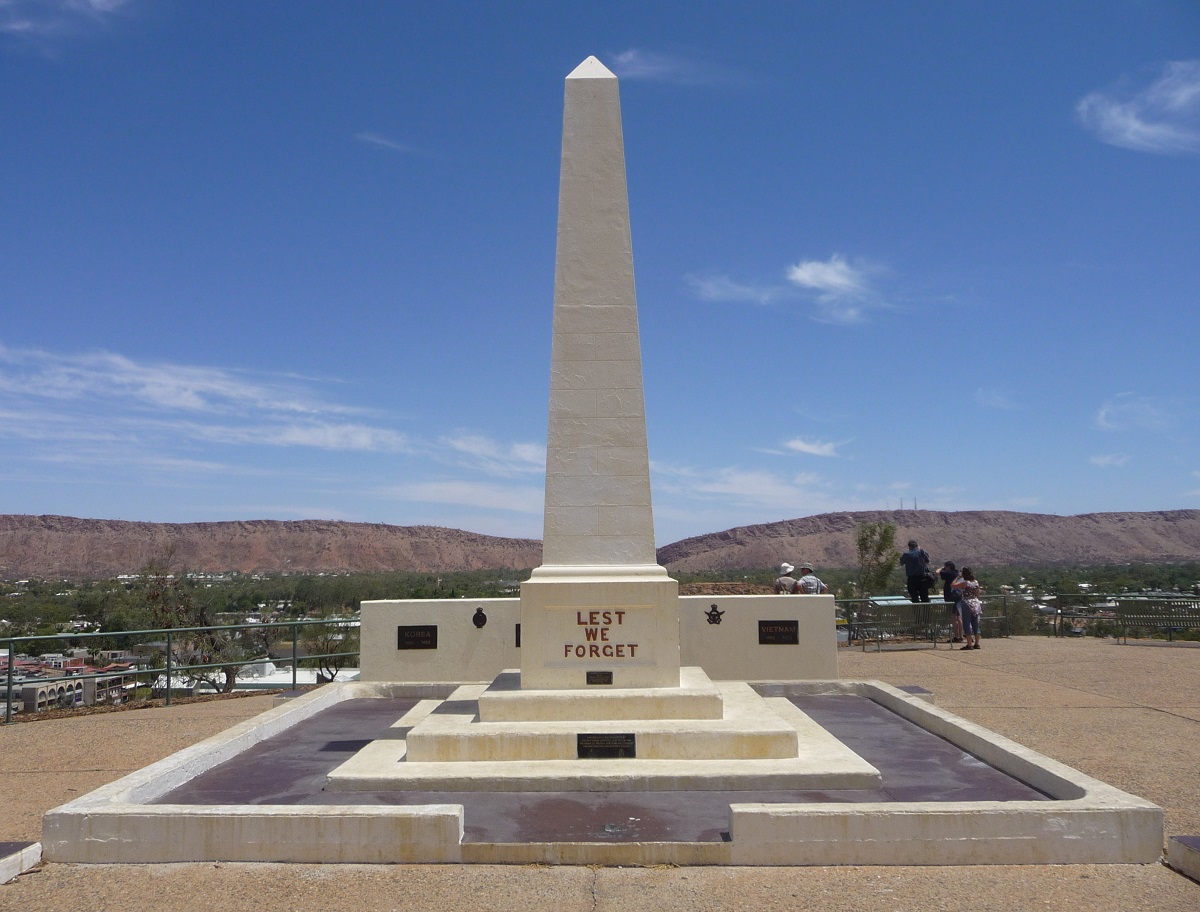
Anzac Hill is a hill located in the center of Alice Springs. The hill is easily accessible, and from the top there is a nice view of the city and the area. Many use the place to enjoy the typical, red sunset.
On Anzac Hill stands the right monument, which was erected in 1934 in memory of those who died in the First World War, in which ANZAC troops took part. ANZAC stands for Australian and New Zealand Army Corps, and they formed the Australian and New Zealand military units under joint command.
Today, the monument on Anzac Hill is a memorial to all those who have fallen in all the wars in which Australia has been involved.
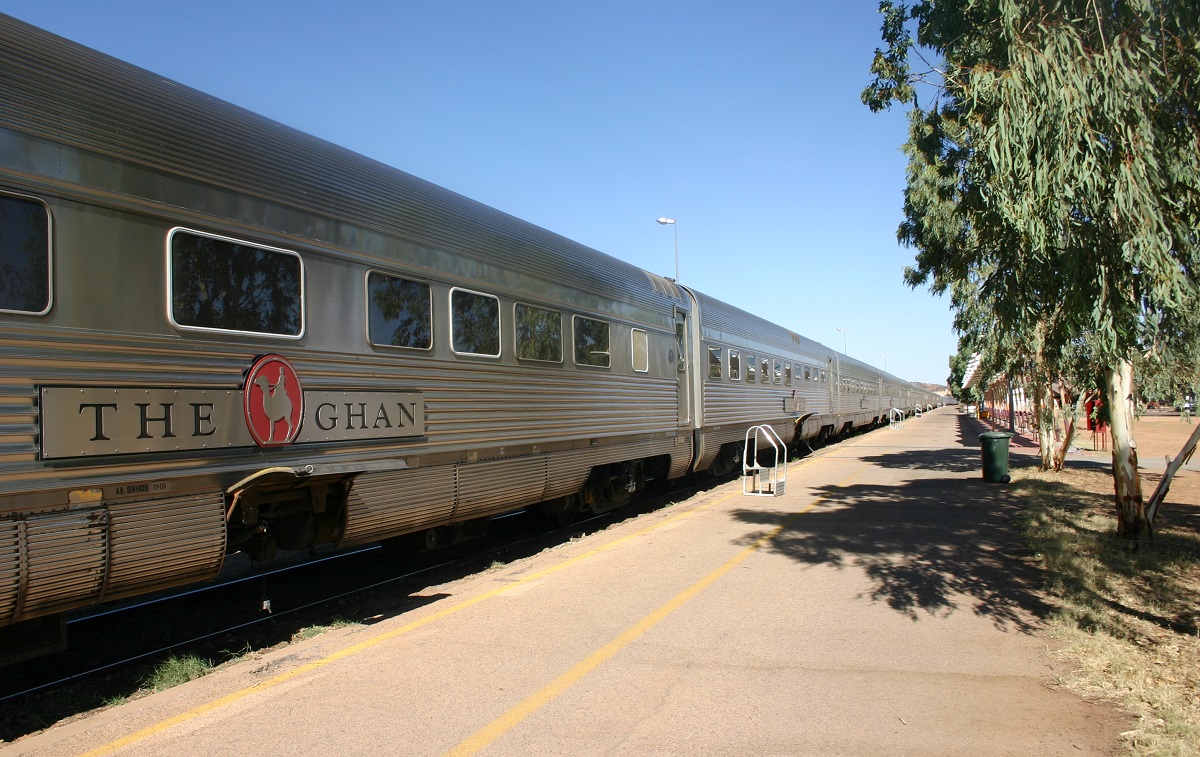
Alice Springs Railway Station is the first thing many people see when they come to Alice Springs. Many come here on the train The Ghan, which made its first trip here from Adelaide in 1929. Until 2004, the railway only went to Alice Springs, but since then The Ghan has crossed the Australian continent the 2,979 km between Adelaide in the south and Darwin in nerd.
Work on building The Ghan began in 1878 in the city of Port Augusta in South Australia. The original line was narrow gauge and followed the Overland Telegraph Line. The connection and operation was increasingly irregular over the years and in 1980 a standard gauge railway could be opened between Tarcoola on the Trans-Australian Railway and Alice Springs. The track had been moved to the west to avoid flooding, which had been a problem on the old line.
The name The Ghan comes from the Afghan camel drivers who, before the opening of the railway, maintained the connection across the continent. In the middle of the platform at Alice Springs Railway Station you can today see a statue of one of these Afghans.
At the station in Alice Springs you can see the modern station building as well as three cabins that were built for the start of the line. Two of the cabins were inhabited by the local people, while the third was for the staff of The Ghan.

Stuart Town Gaol is a building that was constructed as Alice Springs’ jail and police station from 1907, when the town was called Stuart Town. The prison was completed in 1909 and was in use until 1938, when it was converted into a warehouse for the local police.
At the opening of the prison, Stuart Town had a European population of approximately 30 people, and the prison received its first prisoner that year. Before the opening, people were sent to prison in Port Augusta, far to the south. In the prison there was a small cell for European prisoners who could sleep on a wooden bed, and a large cell for Aboriginal people.
Aborigines were often imprisoned for stealing cattle and various goods from the European inhabitants. They went to jail and in Stuart Town Gaol there were 12 iron rings for men and 4 for women to control unruly prisoners. For serious crimes and long sentences, prisoners were transported to Port Augusta, so in Stuart Town the prison was used for relatively minor offences.
Stuart Town Gaol had become overcrowded when it closed in 1938. At the same time, the town had grown considerably since opening in 1909, and by 1938 the prison was in the middle of the town, which was not appropriate. It was succeeded by Her Majesty’s Gaol and Labor Prison, which was considerably larger. Stuart Town Gaol has now been renovated and it stands as an interesting reminder of the time in Alice Springs at the beginning of the 20th century.
Hartley Street School is a small school on Hartley Street in Alice Springs. The school was built in 1929, and it opened in 1930 as the town’s first proper school building. It happened at a time when the population was increasing, which was not least due to the opening of the railway to the city in 1929.
The so-called government resident of Central Australia inaugurated the school, and Pearl Burton became its first teacher. In 1945, a kindergarten opened on the site, and in 1950 the School of the Air started teaching from here. There was a school in the building until 1965, and since 1988 the renovated building has functioned as a museum and also as a cultural centre.
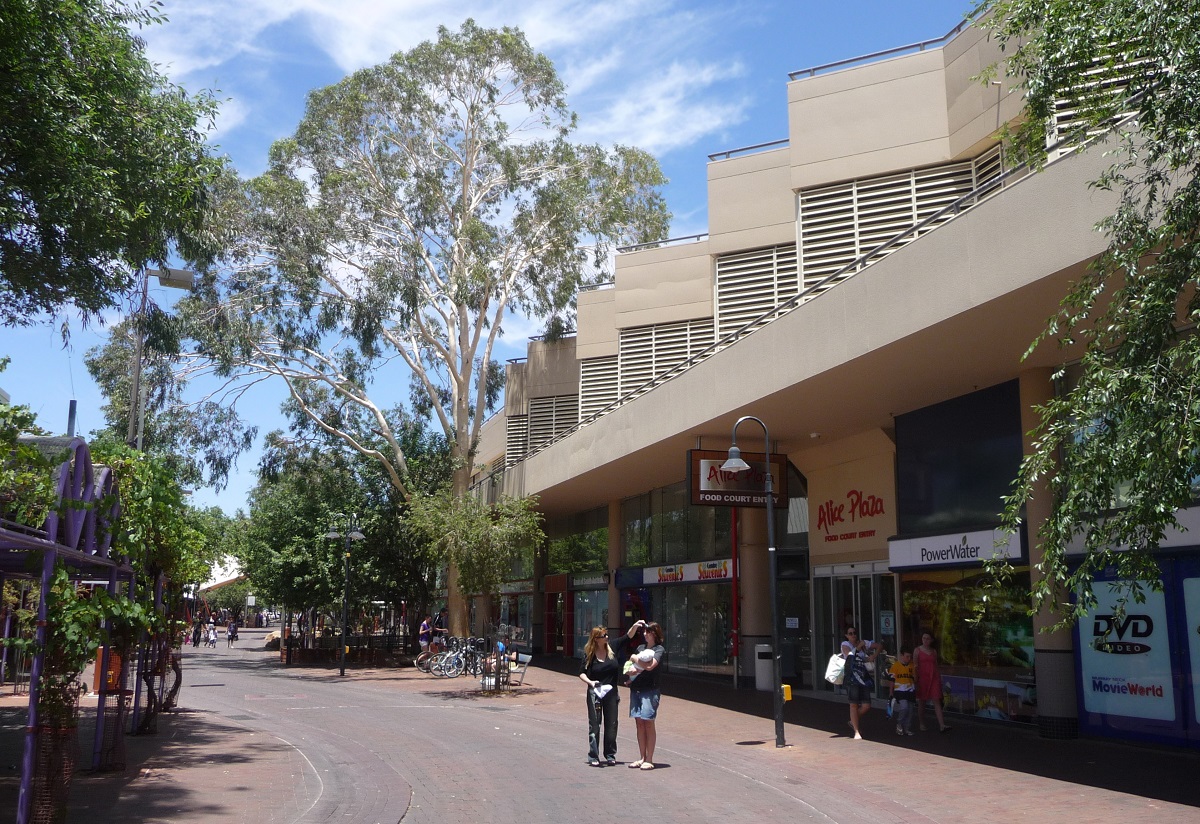
Todd Mall is the name of Alice Springs’ business district. There are shops, restaurants and also a shopping center here. In addition to many ordinary goods, Alice Springs is a good place to look at Aboriginal art, which can be found in a number of places along Todd Mall. A trip to Todd Mall is also a natural place to stroll among the locals.
The central part of present-day Alice Springs was laid out in a right-angled street grid when the town was established at Todd River. It was originally called Stuart Town, and 104 lots were measured out as the beginning of the town. Todd Mall became the main street, and over time several prominent buildings were built along it. You can see, for example, Adelaide House and the John Flynn Memorial Church on the street today.
The Central Australian Aviation Museum is Alice Springs’ aviation museum, and it is located in the city’s former airport. At the museum, you can see various airplanes in the exhibition, where you can also learn about the great importance of air traffic for the development of European civilization in the Northern Territory.
The first plane landed here in 1921, and over the following decades mail was flown around to the large cattle farms. For many, it was the most frequent and for a long time the only connection to the outside world.
In the period 1939-1973, the airline Connellan Airways operated flights for the flying medical corps, the Royal Flying Doctor Service. More than 5,000 medical flights were flown over the years, and at the museum you can see, among other things, two of the historic medical planes. It is a special story because the museum is housed in Connellan Airways’ old hangar.
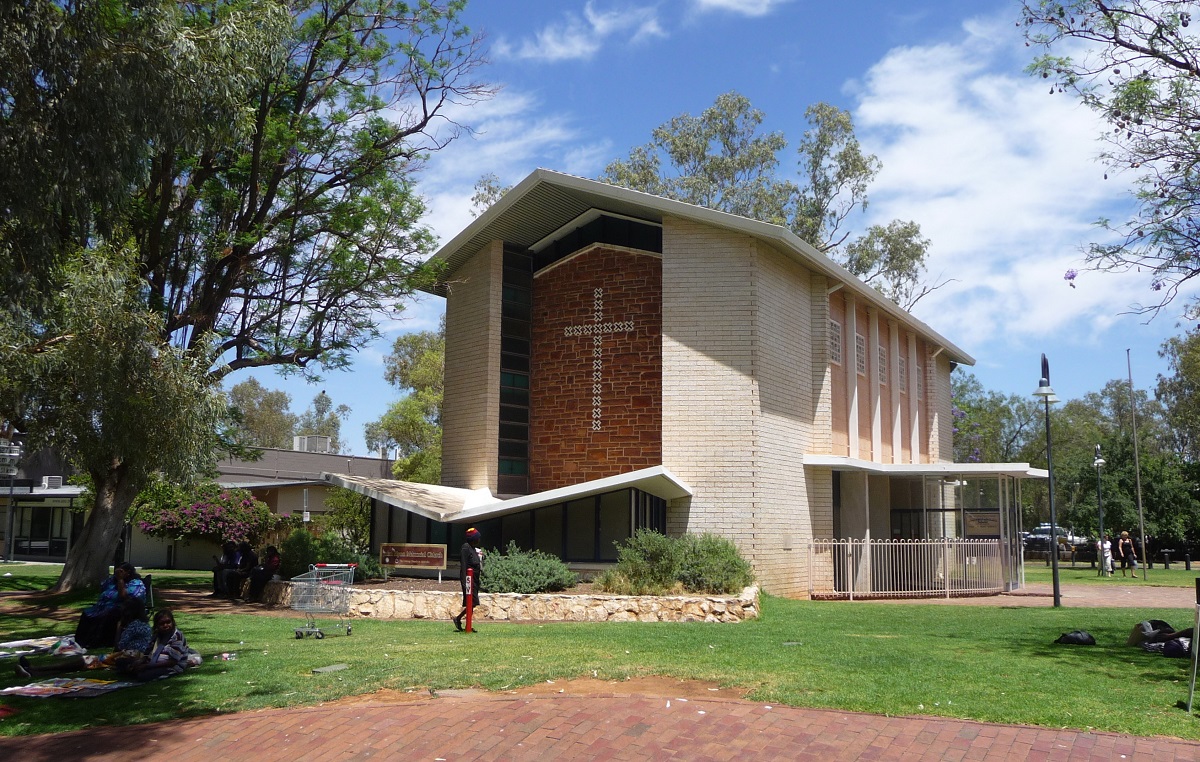
John Flynn Memorial Church is a church located on Todd Mall in the center of Alice Springs. The church is named after John Flynn, who had a dream to build a cathedral in central Australia where people of all faiths could come. After Flynn’s death, the church was built in his memory and dedicated in 1956.
John Flynn was a pastor and founder of the organization Australian Inland Mission, and he worked to improve conditions for the inhabitants of central Australia, who often lived quite far from cities and facilities such as medical care. Among Flynn’s initiatives was the construction of Adelaide House in what was then Stuart in 1928 as the city’s first hospital, and his initiatives also led to the formation of The Royal Flying Doctor Service.
Flynn died in 1951, with his remains interred in the western part of Alice Springs along Larapinta Drive. A large rock stone was placed on top of the grave, but this had to be replaced with another in 1998, as the original stone had been taken from a sacred site for the Aboriginal people. Today you can see the grave site, formally called the John Flynn’s Grave Historical Reserve.

Adelaide House is a building on the main street of Todd Mall in Alice Springs. The house was built in 1926 at the behest of Rev. John Flynn, and it was opened as the city’s first purpose-built hospital. Flynn was often in central Australia, and he had a goal to improve conditions for the region’s inhabitants.
Before the opening of Adelaide House, there was no resident doctor in Stuart or Alice Springs and the population had to treat themselves or get help via the telegraph line from the Alice Springs telegraph station. It caused quite a few problems with healing in case of illness or resulted in deaths that could have been avoided.
Adelaide House served as a hospital for all from 1928, with Aboriginal people no longer able to use the site from 1934. In 1938, Adelaide House was replaced by a larger and newly built hospital, and the house then continued to house children whose parents had been admitted to the hospital. Today the house is open as a historical museum.

The Old Courthouse is a building which was part of the Administrative Offices of Central Australia, established in 1926 as part of the future self-government. Self-government was a reality in the years 1927-1931, when the territory of Central Australia was administered from Stuart, which in 1933 was named Alice Springs.
Construction of the Old Courthouse continued from 1927, and the building was ready for occupancy in November 1928. Until then it had been a local courthouse at the nearby telegraph station, but this was moved to the new house in Stuart, which, among other things, served as the Supreme Court of the Territory from 1929 to 1931. The house continued as a courthouse until 1980, when a new and larger building was inaugurated.

The Residency is a house that was built in 1928, when Alice Springs, then named Stuart, became the capital of the short-lived Territory, Central Australia. With this status, the city was given a governor who was the monarch’s representative and supreme authority in the territory. Thereby, The Residency stands as a monument of its time.
The house was built in the local style with a core of stone with a surrounding veranda. This arrangement was good for life in the house both in summer and winter. Over time, several prominent people visited here. This applied, among others, to Queen Elizabeth II and the Duke of Edinburgh, who visited The Residency in 1963.
Alice Spring Desert Park is a miniature version of the landscape and wildlife of central Australia. There are hiking trails where you come through different desert landscapes, such as a river area and an actual sandy desert. Along the paths there are informative signs about what you see and experience.

Pioneer Theater is an old cinema building which today belongs to the Youth Hostels Association, which runs hostels in many places in Australia. It was Leslie Kenna who built the cinema in 1942 in period architecture with clear Art Deco features.
Leslie Kenna had come to Alice Springs in 1936 with a large amount of film and projection equipment, and initially he rented out the then Capitol Theater where he ran a cinema. The screening of films was important in the city at the time, and for the Aboriginal population it was one of the few opportunities to enter the city, which was otherwise closed to them from 1928 to 1964.
In 1942, Leslie Kenna built the Pioneer Theater so he had his own place. It was a building without a roof, because there was no air conditioning in Alice Springs at the time, and therefore the missing roof served as ventilation in the evenings. When it was cold, moviegoers brought blankets and hot drinks. The place was open as a cinema until 1984.
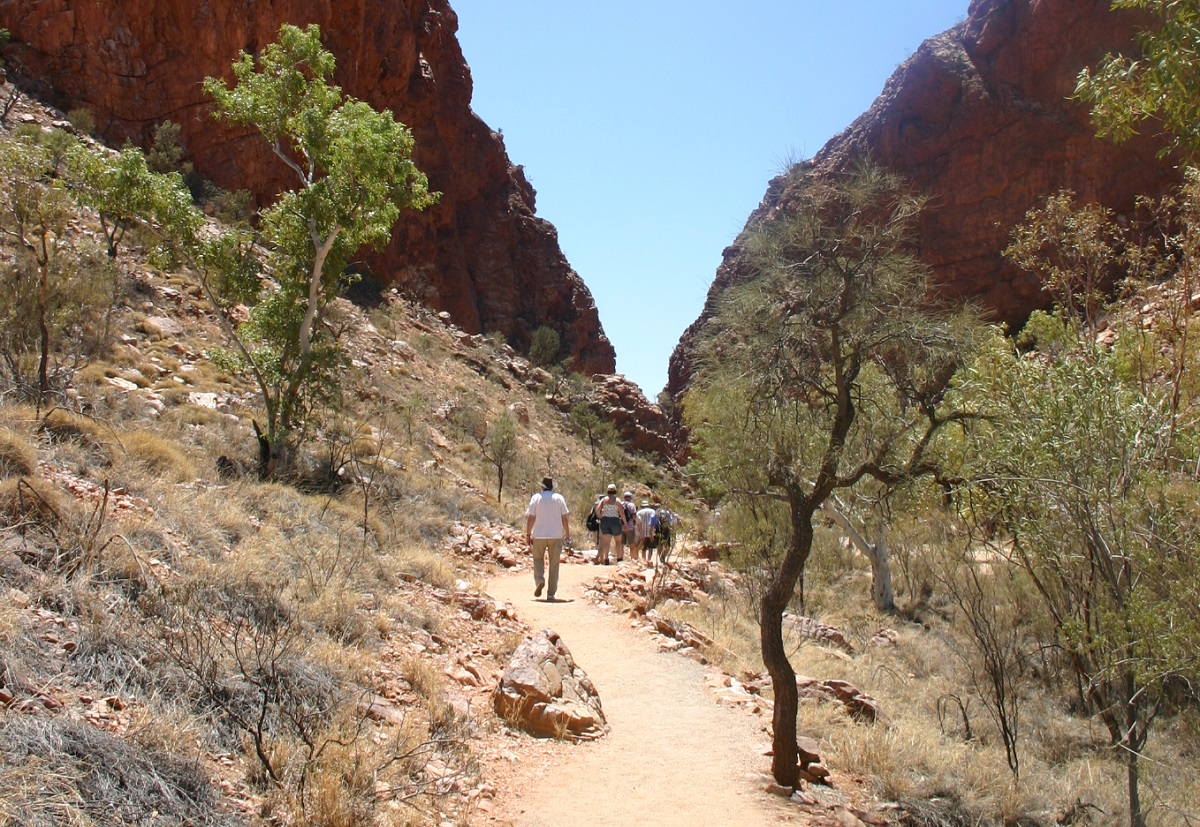
Simpson’s Gap is a mountain pass that has been formed over time by water cutting through the mountains of the West MacDonnell Ranges. You can walk along the river bed to Simpson’s Gap itself, where the life-giving water lies like a lake on the surface.
The walk is beautiful and there are countless interesting plants, and the place is known as one of the areas where you can be lucky to see some of the black-footed mountain kangaroos, known locally as Black-footed Rock-wallabies.

King’s Canyon is a gorge cut 300 meters into the central Australian mountains by the stream King’s Creek, which runs in the lush valley in the middle of the area that tourists usually visit.
The mountain walls around the valley rise steeply, and you can choose to hike both through the valley and along the cliff edge around the valley. Both tours are beautiful, and they give quite a different impression of the magnificent nature.
The trip through the valley is approximately two kilometers long, and at the bottom of the gorge there is a platform where you really get a look up at the mountain slopes.
The trip to the top and along the edge of the cliff is a round trip of six kilometers. Already at the steep ascent of Heartbreak Hill you are rewarded with a fine view of the surrounding terrain. Among the highlights of this tour is Edens Have/Garden of Eden, which is a permanent waterhole that sits as a green oasis. The view of countless sandstone formations that stand like domes in the landscape is also very breathtaking.
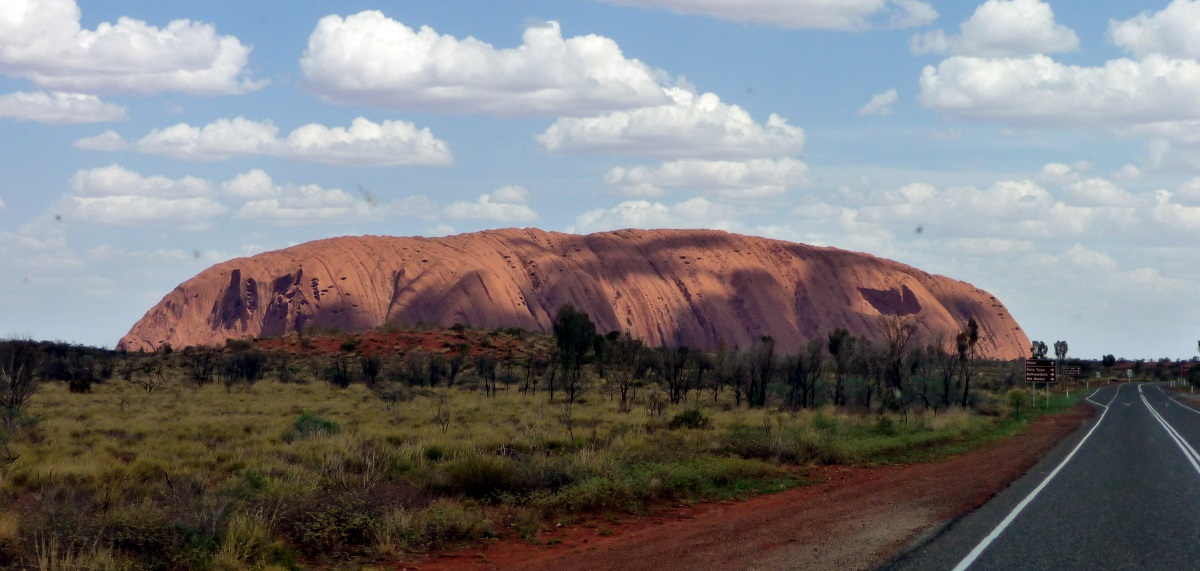
Uluru Ayers Rock is one of Australia’s best-known landmarks, and the large rock is today included on UNESCO’s list of world heritage sites for nature and culture. Uluru Ayers Rock is one of the world’s largest rocks, and it lies as if thrown with gigantic force into the otherwise completely flat plain. Geologically, Uluru Ayers Rock is a monolith, which means an unbroken rock, and it has been determined that it goes at least 6 kilometers into the ground. The stone comes from a historic mountain range to the west, and from here it has ended up in its current location. If you look at the structure of the stone, you can see that it actually stands on the edge.
Both nearby Kata Tjuta The Olgas and Uluru Ayers Rock were created in a process that began approximately 550 million years ago. Back then, the Petermann Ranges to the west were much higher than today. Rain eroded sand and rock from the rocks that spread like fans at the foot of the mountains. A fan of sand and one of rocks. About 500 million years ago, the area was covered by water, turning the place into a sea, and the fans were also covered on that occasion by mud, sand and, of course, water. The weight turned the sandy fan into sandstone, while the rocks became the sedimentary rock conglomerate, which is a type of petrified sand and clay. In that process, the sandy fan became Ulura Ayers Rock, while the rock fan became Kata Tjuta The Olgas.
The years passed and 400 million years ago the sea again disappeared from the area, starting the period also known as the Alice Springs Orogeny, where plate tectonic events created several major mountain ranges and changed the landscape towards the interior of Australia we know today. Cliffs changed shapes and heights, and the monoliths of the Petermann Ranges were pushed. The many rocks in Kata Tjuta The Olgas were angled slightly during the geological process, while Uluru Ayers Rock was turned 90 degrees and thus came to stand on top. Later, approximately 300 million years ago, the softer rocks eroded, revealing both Uluru Ayers Rock and Kata Tjuta The Olgas.
Today, Uluru Ayers Rock measures 348 meters in height from the surrounding terrain, and thus the vast majority of the monolith is hidden underground. The circumference of the stone is a whopping 9.8 kilometers. It is famous for its almost magical play of colors that vary with the sunlight, and both morning and evening crowds of spectators gather at the stone to enjoy the reddish-brown colors that make the stone almost glow. On organized tours, coffee or bubbles are often served depending on the time.
Uluru is the Aboriginal name of the place, while Ayers Rock was given in 1873 when the first European climbed the rock and named it after the Prime Minister of the colony of South Australia, Henry Ayers. Today, the two names have been merged into Uluru Ayers Rock, and thereby there is a name-wise connection between the indigenous people and modern and European-developed Australia.
Around Uluru Ayers Rock there is a walking path that forms the so-called base walk. It is approximately ten kilometers long, and the trip is highly recommended, as you get to see all the details of the rock up close and at the same time have the peace to enjoy the magnificent nature of which Uluru Ayers Rock is a part. And on the trip, most people are surprised by the great variety in the stone itself on the way around.
Uluru Ayers Rock is part of the Uluru-Kata Tjuta National Park, which was traditionally inhabited by the Aboriginal Anangu people, who were formally granted land rights to the area in 1985. In this connection, a leasing agreement was entered into with the Australian government so that the national park could be maintained open, and today there is a collaboration to maintain the park and convey Aboriginal culture. South of the stone is the Aboriginal-run Cultural Centre, which provides a fine introduction to the area with its history and attractions.
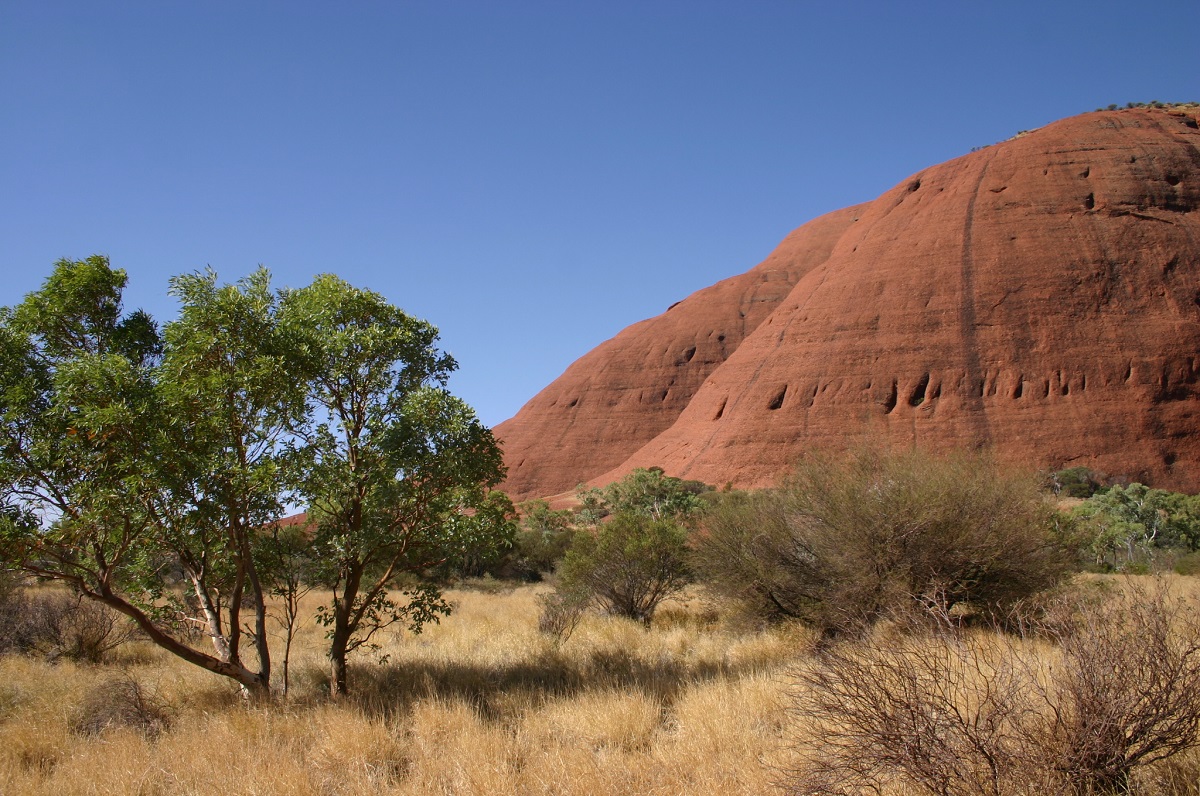
Kata Tjuta The Olgas is a beautiful site just west of Uluru Ayers Rock, which consists of an area of 36 round-topped rock formations rising up to 545 meters above the surrounding terrain. Kata Tjuta The Olgas, like Uluru Ayers Rock, consists of monoliths originating from a now collapsed mountain range to the west. The many monoliths originate from a protracted geological process that lasted approximately 250 million years.
Kata Tjuta The Olgas, like Uluru Ayers Rock, was created in a process that began approximately 550 million years ago. The Petermann Ranges were and still are a mountain range to the west, and back then it was much higher than today. Rain eroded sand and rock from the rocks that spread like fans at the foot of the mountains. A fan of sand and one of rocks. About 500 million years ago, the area was covered by water, turning the place into a sea, and the fans were also covered on that occasion by mud, sand and, of course, water. The weight turned the sandy fan into sandstone, which we know as Uluru Ayers Rock, while the rocks became the sedimentary rock conglomerate, which is a type of petrified sand and clay. The conglomerate was formed into Kata Tjuta The Olgas.
The years passed and 400 million years ago the sea again disappeared from the area, starting the period also known as the Alice Springs Orogeny, where plate tectonic events created several major mountain ranges and changed the landscape towards the interior of Australia we know today. Cliffs changed shapes and heights, and the monoliths of the Petermann Ranges were pushed. The many rocks in Kata Tjuta The Olgas were angled slightly during the geological process, while Uluru Ayers Rock was turned 90 degrees and thus came to stand on top. Later, approximately 300 million years ago, the softer rocks eroded, revealing both Uluru Ayers Rock and Kata Tjuta The Olgas.
Today, Kata Tjuta The Olgas are up to 545 meters above ground, but the real height of the monoliths is much greater when the underground parts are included. Kata Tjuta The Olgas is a sacred place for the Aboriginal people. Kata Tjuta is an Aboriginal name for the area, and it refers to the many-headed appearance of the rocks. The name The Olgas comes from the site’s highest point, Mount Olga, which in 1872 was named after German Württemberg’s Queen Olga. The reason for this was as a thank you from the discoverer Ernest Giles, who via Baron Ferdinand von Müller owed a thank you to Queen Olga for an appointment.
There are good hiking opportunities in the very red and exciting rocks. A trip through Vindenes Dal/Valley of the Winds is unforgettable, and if you want to see it all from a distance, the best place is the panoramic area west of the rock formations. Many will also choose a walk in the Walpa Gorge, where nature has almost created a temple with steep rock walls on both sides. On the tours you can enjoy the area’s flora, and in Walpa Gorge, for example, you may be lucky enough to see wallaroos, which are between wallabies and kangaroos in size.
Todd Mall
Bath Street
36-38 Hartley Street
yeperenye.com.au
Todd Mall
Stuart Terrace 9
reptilecentre.com.au
Larapinta Drive
alicespringsdesertpark.com.au
Stuart Terrace
flyingdoctor.net
Central Australia is believed to have been inhabited for tens of thousands of years, of which the local Arrente-people have been in the area for the past millennia.
The Arrente people consisted of three groupings: Western, Eastern and Central, all living in Central Australia around the present Alice Springs and MacDonnell Ranges.
The culture and language of the people continue to thrive today, and the Eastern and Central Arrente languages are the dominant one in the region where the Arrente name of Alice Springs is Mparntwe.
Alice Springs is located in the middle of Australia, far from all the major cities of the country. The non-Aboriginal presence in the area started with John McDouall Stuart’s expedition to find the way across the Australian landmassy from south to north in 1862.
After Stuart’s voyage, a telegraph line, The Overland Telegraph Line, was constructed from Adelaide to Darwin, and the center of the telegraph station was called Alice Springs, believed to have found a water source at the exact location of the telegraph station itself. The name Alice comes from Charles Todd’s wife named Alice. Charles Todd, who has given his name to the Todd River, was responsible, among other things, for the construction of the Telegraph Line in the South Australia Colony.
After the construction of the telegraph station, the first citizens established themselves around it, and the settlement was called Stuart until 1933, when it was officially called Alice Springs. The town grew slightly from 1887, when gold was found east of the city, but until well into the 1900s there were only a few hundred inhabitants.
Alice Springs was quite isolated, and for the first several years the camel caravans carried out the transport to and from the town. The isolation was broken only when the Adelaide railway line was opened in 1929. The city has grown steadily since then, and today Alice Springs is home to about 27,000 citizens.
The tourist industry is big in the city and there are daily flights from several of the Australian metropolitan areas. Since the beginning of 2004 it has also been possible to drive by train from Darwin in the north, which has created extra traffic and more opportunities for the tourist industry, which not least organizes trips to the magnificent scenery here in the heart of Australia, for example to Uluru Ayers Rock and Kata Tjuta The Olgas.
 Alice Springs, Australia[/caption]
Alice Springs, Australia[/caption]
Overview of Alice Springs
Alice Springs is in Australia’s interior called The Red Center, and with the red color of the soil, you quickly see why. The sunsets add an extra red glow and that is just the icing on the cake. Already from the air you can see the red earth, and in the middle of it all you find the oasis Alice Springs, which despite its relatively small population is like a big city in the desert.
The city of Alice Springs is not one of Australia’s largest, but on the other hand the sights are unique. The history of colonizing and developing the vast land area is something that one can follow around the city, which also serves as a kind of capital for the country’s indigenous population, the Aborigines, whose arts and traditions, you can see several places in the city.
About the Whitehorse travel guide
Contents: Tours in the city + tours in the surrounding area
Published: Released soon
Author: Stig Albeck
Publisher: Vamados.com
Language: English
About the travel guide
The Whitehorse travel guide gives you an overview of the sights and activities of the Canadian city. Read about top sights and other sights, and get a tour guide with tour suggestions and detailed descriptions of all the city’s most important churches, monuments, mansions, museums, etc.
Whitehorse is waiting for you, and at vamados.com you can also find cheap flights and great deals on hotels for your trip. You just select your travel dates and then you get flight and accommodation suggestions in and around the city.
Read more about Whitehorse and Canada
Canada Travel Guide: https://vamados.com/canada
City tourism: https://visitwhite-horse.ca
Main Page: https://www.vamados.com/
Buy the travel guide
Click the “Add to Cart” button to purchase the travel guide. After that you will come to the payment, where you enter the purchase and payment information. Upon payment of the travel guide, you will immediately receive a receipt with a link to download your purchase. You can download the travel guide immediately or use the download link in the email later.
Use the travel guide
When you buy the travel guide to Whitehorse you get the book online so you can have it on your phone, tablet or computer – and of course you can choose to print it. Use the maps and tour suggestions and you will have a good and content-rich journey.


Alice Springs Railway Station is the first thing many people see when they come to Alice Springs. Many come here on the train The Ghan, which made its first trip here from Adelaide in 1929. Until 2004, the railway only went to Alice Springs, but since then The Ghan has crossed the Australian continent the 2,979 km between Adelaide in the south and Darwin in nerd.
Work on building The Ghan began in 1878 in the city of Port Augusta in South Australia. The original line was narrow gauge and followed the Overland Telegraph Line. The connection and operation was increasingly irregular over the years and in 1980 a standard gauge railway could be opened between Tarcoola on the Trans-Australian Railway and Alice Springs. The track had been moved to the west to avoid flooding, which had been a problem on the old line.
The name The Ghan comes from the Afghan camel drivers who, before the opening of the railway, maintained the connection across the continent. In the middle of the platform at Alice Springs Railway Station you can today see a statue of one of these Afghans.
At the station in Alice Springs you can see the modern station building as well as three cabins that were built for the start of the line. Two of the cabins were inhabited by the local people, while the third was for the staff of The Ghan.

Stuart Town Gaol is a building that was constructed as Alice Springs’ jail and police station from 1907, when the town was called Stuart Town. The prison was completed in 1909 and was in use until 1938, when it was converted into a warehouse for the local police.
At the opening of the prison, Stuart Town had a European population of approximately 30 people, and the prison received its first prisoner that year. Before the opening, people were sent to prison in Port Augusta, far to the south. In the prison there was a small cell for European prisoners who could sleep on a wooden bed, and a large cell for Aboriginal people.
Aborigines were often imprisoned for stealing cattle and various goods from the European inhabitants. They went to jail and in Stuart Town Gaol there were 12 iron rings for men and 4 for women to control unruly prisoners. For serious crimes and long sentences, prisoners were transported to Port Augusta, so in Stuart Town the prison was used for relatively minor offences.
Stuart Town Gaol had become overcrowded when it closed in 1938. At the same time, the town had grown considerably since opening in 1909, and by 1938 the prison was in the middle of the town, which was not appropriate. It was succeeded by Her Majesty’s Gaol and Labor Prison, which was considerably larger. Stuart Town Gaol has now been renovated and it stands as an interesting reminder of the time in Alice Springs at the beginning of the 20th century.
Hartley Street School is a small school on Hartley Street in Alice Springs. The school was built in 1929, and it opened in 1930 as the town’s first proper school building. It happened at a time when the population was increasing, which was not least due to the opening of the railway to the city in 1929.
The so-called government resident of Central Australia inaugurated the school, and Pearl Burton became its first teacher. In 1945, a kindergarten opened on the site, and in 1950 the School of the Air started teaching from here. There was a school in the building until 1965, and since 1988 the renovated building has functioned as a museum and also as a cultural centre.

Todd Mall is the name of Alice Springs’ business district. There are shops, restaurants and also a shopping center here. In addition to many ordinary goods, Alice Springs is a good place to look at Aboriginal art, which can be found in a number of places along Todd Mall. A trip to Todd Mall is also a natural place to stroll among the locals.
The central part of present-day Alice Springs was laid out in a right-angled street grid when the town was established at Todd River. It was originally called Stuart Town, and 104 lots were measured out as the beginning of the town. Todd Mall became the main street, and over time several prominent buildings were built along it. You can see, for example, Adelaide House and the John Flynn Memorial Church on the street today.
The Central Australian Aviation Museum is Alice Springs’ aviation museum, and it is located in the city’s former airport. At the museum, you can see various airplanes in the exhibition, where you can also learn about the great importance of air traffic for the development of European civilization in the Northern Territory.
The first plane landed here in 1921, and over the following decades mail was flown around to the large cattle farms. For many, it was the most frequent and for a long time the only connection to the outside world.
In the period 1939-1973, the airline Connellan Airways operated flights for the flying medical corps, the Royal Flying Doctor Service. More than 5,000 medical flights were flown over the years, and at the museum you can see, among other things, two of the historic medical planes. It is a special story because the museum is housed in Connellan Airways’ old hangar.

John Flynn Memorial Church is a church located on Todd Mall in the center of Alice Springs. The church is named after John Flynn, who had a dream to build a cathedral in central Australia where people of all faiths could come. After Flynn’s death, the church was built in his memory and dedicated in 1956.
John Flynn was a pastor and founder of the organization Australian Inland Mission, and he worked to improve conditions for the inhabitants of central Australia, who often lived quite far from cities and facilities such as medical care. Among Flynn’s initiatives was the construction of Adelaide House in what was then Stuart in 1928 as the city’s first hospital, and his initiatives also led to the formation of The Royal Flying Doctor Service.
Flynn died in 1951, with his remains interred in the western part of Alice Springs along Larapinta Drive. A large rock stone was placed on top of the grave, but this had to be replaced with another in 1998, as the original stone had been taken from a sacred site for the Aboriginal people. Today you can see the grave site, formally called the John Flynn’s Grave Historical Reserve.

Adelaide House is a building on the main street of Todd Mall in Alice Springs. The house was built in 1926 at the behest of Rev. John Flynn, and it was opened as the city’s first purpose-built hospital. Flynn was often in central Australia, and he had a goal to improve conditions for the region’s inhabitants.
Before the opening of Adelaide House, there was no resident doctor in Stuart or Alice Springs and the population had to treat themselves or get help via the telegraph line from the Alice Springs telegraph station. It caused quite a few problems with healing in case of illness or resulted in deaths that could have been avoided.
Adelaide House served as a hospital for all from 1928, with Aboriginal people no longer able to use the site from 1934. In 1938, Adelaide House was replaced by a larger and newly built hospital, and the house then continued to house children whose parents had been admitted to the hospital. Today the house is open as a historical museum.

The Old Courthouse is a building which was part of the Administrative Offices of Central Australia, established in 1926 as part of the future self-government. Self-government was a reality in the years 1927-1931, when the territory of Central Australia was administered from Stuart, which in 1933 was named Alice Springs.
Construction of the Old Courthouse continued from 1927, and the building was ready for occupancy in November 1928. Until then it had been a local courthouse at the nearby telegraph station, but this was moved to the new house in Stuart, which, among other things, served as the Supreme Court of the Territory from 1929 to 1931. The house continued as a courthouse until 1980, when a new and larger building was inaugurated.

The Residency is a house that was built in 1928, when Alice Springs, then named Stuart, became the capital of the short-lived Territory, Central Australia. With this status, the city was given a governor who was the monarch’s representative and supreme authority in the territory. Thereby, The Residency stands as a monument of its time.
The house was built in the local style with a core of stone with a surrounding veranda. This arrangement was good for life in the house both in summer and winter. Over time, several prominent people visited here. This applied, among others, to Queen Elizabeth II and the Duke of Edinburgh, who visited The Residency in 1963.
Alice Spring Desert Park is a miniature version of the landscape and wildlife of central Australia. There are hiking trails where you come through different desert landscapes, such as a river area and an actual sandy desert. Along the paths there are informative signs about what you see and experience.

Pioneer Theater is an old cinema building which today belongs to the Youth Hostels Association, which runs hostels in many places in Australia. It was Leslie Kenna who built the cinema in 1942 in period architecture with clear Art Deco features.
Leslie Kenna had come to Alice Springs in 1936 with a large amount of film and projection equipment, and initially he rented out the then Capitol Theater where he ran a cinema. The screening of films was important in the city at the time, and for the Aboriginal population it was one of the few opportunities to enter the city, which was otherwise closed to them from 1928 to 1964.
In 1942, Leslie Kenna built the Pioneer Theater so he had his own place. It was a building without a roof, because there was no air conditioning in Alice Springs at the time, and therefore the missing roof served as ventilation in the evenings. When it was cold, moviegoers brought blankets and hot drinks. The place was open as a cinema until 1984.
Similar to Alice Springs Travel Guide
